Physical Address
304 North Cardinal St.
Dorchester Center, MA 02124
Cocaine is one of the most commonly used illicit drugs in the United States. Between 2011 and 2015, there was an increased prevalence of cocaine use in individuals aged 12 and older of 20%. Additionally, in 2015 alone about 968,000 individuals aged 12 and older initiated cocaine use. This was the largest increase in cocaine use since 2008. Females tend to use cocaine at younger ages, become dependent on cocaine quicker, and have more adverse events when compared to males. Blacks are also more likely to be affected by cocaine use than other ethnicities. In fact, in the United States, 46% of admissions for cocaine use in 2015 were Black. Each year in the United States more than 400,000 individuals present to the emergency department (ED) for cocaine-related issues. This accounts for about 40% of all drug-related visits. Half of these are related to cardiovascular toxicity with 40% complaining of chest pain. About a quarter of nonfatal myocardial infarctions in people aged 18 to 45 are attributable to cocaine use. Hospital admissions for cocaine-related chest pain are estimated to cost annually between $155 and $226 million.
Cocaine is a powerful sympathomimetic that acts by directly stimulating central sympathetic outflow and blocking presynaptic uptake of norepinephrine and dopamine. This augmentation in postsynaptic catecholamine increases heart rate, mean arterial pressure, and left ventricular (LV) contractility through stimulation of both α- and β-adrenergic receptors. Through enhanced α-adrenergic receptor activation, increased endothelin production, and diminished nitric oxide generation, cocaine leads to coronary artery vasoconstriction.
Cocaine may also enhance platelet aggregation and thrombus formation through heightened production of adenosine diphosphate, thromboxane A 2 , and tissue plasminogen activator inhibitors, as well as reductions in protein C and antithrombin III. A study demonstrated that intravenous cocaine administration can activate circulating platelets via increased expression of P-selectin found on surfaces of the activated platelets.
Cocaine causes toxic effects on cardiac muscle that arise primarily from Ca 2+ overload during excessive β-adrenergic stimulation. Adventitial mast cells may potentiate atherosclerosis, vasospasm, thrombosis, and premature sudden death in long-term cocaine abusers.
Cocaine is well absorbed through all body mucous membranes and can be administered by nasal, sublingual, intramuscular, intravenous, and respiratory routes. The onset of action varies from 3 seconds to 5 minutes, depending on the route of administration. The proposed potential mechanism of the cardiovascular effects of cocaine when beta-blockers are administered in cocaine-induced acute coronary syndrome is summarized in Fig. 49.1 .

Cardiopulmonary complaints are the most commonly reported symptoms in patients after cocaine use, occurring in 56% of cases. Chest pain is the most common symptom and is typically described as a pressure sensation. Other common symptoms include dyspnea, anxiety, palpitations, syncope, dizziness, and nausea. The onset of symptoms usually occurs soon after ingestion with two-thirds of patients presenting within 3 hours.
The cardiac and systemic effects of cocaine are complex. Most complications occur in the first 24 hours, but a case report suggested late effects even after 2 weeks resulting in an LV thrombus due to LV dysfunction. Cocaine-induced increase in sympathomimetic activity results in increased myocardial contractility, heart rate, blood pressure, and myocardial oxygen demand while simultaneously decreasing myocardial oxygen supply due to vasoconstriction.
The clinical cardiovascular consequences of cocaine use include hypertensive crises, acute myocardial infarction (AMI), aortic dissection, and stroke. Premature coronary atherosclerosis has been seen in young cocaine abusers, with obstructive coronary artery disease (CAD) seen in 35% to 40% of patients who undergo angiography for cocaine-associated chest pain. Cocaine may depress LV function in the absence of acute coronary ischemia because of its direct effect on cardiac muscle, therefore leading to myocarditis and cardiomyopathy. Oxidative stress is major mechanism of cocaine-induced cardiomyopathy.
Cocaine exhibits properties of a class I antiarrhythmic agent by Na-channel blockade. It also prolongs the duration of the QT interval by inhibiting myocyte repolarization that occurs by the efflux of potassium. Cocaine also increases intracellular calcium with resultant afterdepolarizations, reduces vagal activity, and increases myocyte irritability by inducing ischemia. Ischemia due to vasospasm and fatal ventricular arrhythmias due to ischemia are presumed to be important mechanisms of sudden death in these patients.
The clinical cardiovascular complications of cocaine are summarized in Fig. 49.2 .

Based on reported rates, AMI is thought to occur in about 6% of patients presenting to the ED with cocaine-associated chest pain. AMI occurs within minutes to days after cocaine exposure, independent of dose, length of use, or route of administration. However, the time during which individuals are at higher risk for developing AMI is within the first hour of cocaine use as the risk of AMI increases 24-fold during that time period.
Become a Clinical Tree membership for Full access and enjoy Unlimited articles
If you are a member. Log in here